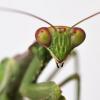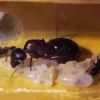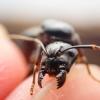Unfortunately, because of the locations of my formicarium, it's not possible to do a space heater to heat the entire environment. The heatlamp seems to work well and since the colonies are 36 inches from the bulb, there doesn't seem like there is all that much gradient or hot/cold spots in this setup. Using a laser thermometer, it seems like a variance of <1 f is happening from the top of the mini-hearths to the bottom.
That's why I can't seem to figure out why there is condensation on this one colony, and not the others. These worked very hard as they were going into diapause, moving sand around, and apparently blocking the tiny cracks between the nest and the glass. Also the piled sand over about half the water tower. Just a few days ago I started to see condensation - it happened suddenly, no change in the environment. The whole front was covered in condensation. Because they were covering the water tower, I thought maybe they need more ventilation so I took the nestmate (which was full of water) and emptied it and put it in as a vent. After 48 hours, the condensation is reduced, but not that much.
It's really strange, I can't seem to figure this out. There are 2 identical setups inches away and they are completely free of condensation.
Before I ever studied the topic, I too thought it acceptable to heat one side of a formicarium, test tube, or other container. The problem is that ants typically favor setups with poor ventilation, which is why you have observed the ants using small particles to "seal" any small gaps where air may otherwise enter. Consequently, when you are providing direct heat to one side of the formicarium, any nest or container with a high relative humidity will begin to produce condensation almost immediately when the heat source is turned off, moved, or the environment becomes cooler, thereby decreasing the temperature of the formicarium glass/plastic.
Condensation is not random, it is able to be calculated mathematically with 100% accuracy—we call the conditions under which water vapor condenses in response to changes in temperature, "dew point."
As an example, at >98% relative humidity (RH), if the temperature of the glass becomes merely 1 °F less than the temperature inside the nest, water will begin to condense onto the coolest available surface—in your case, the front glass. At 86% RH, you have about 5 °F tolerance before water begins to condense onto the glass. At 70% RH, you have about 10 °F tolerance.
This means that at extremely high relative humidities, you have virtually no thermal tolerance for inhibiting condensation in poorly ventilated nests. And lower humidities may be infeasible in small setups, because eggs typically require the most RH to avoid drying out (≥86%), and pupae the least. In many cases, a relative humidity gradient is probably a more important feature in a formicarium than a temperature gradient.
The small vent you added, which is attached to tubing, may help a little to decrease the relative humidity, but only if the output—the water vapor going out of the vent—exceeds the input—water vapor produced by the "water tower," respirating ants, and other sources of humidity inside the nest. Try to keep the RH inside the nest between 70-86%, and avoid directly heating only one side or surface.
Finally, keep in mind that a heat lamp emits infrared heat that is absorbed by water, energizing it and evaporating it, thereby pushing the RH further upwards, which may almost certainly exacerbate any condensation issues you're having. So I continue to recommend the optimal setup of a dedicated small room, such as a closet or bathroom, in which a space heater would be able to economically maintain a set temperature (especially accurately with an inexpensive temperature controller), thereby avoiding any hot/cold spots and temperature swings which are responsible for your condensation issues.
Edited by drtrmiller, April 19 2019 - 11:47 AM.

















